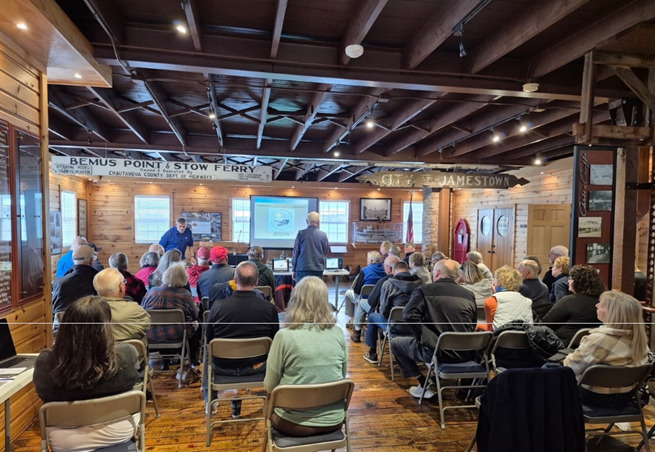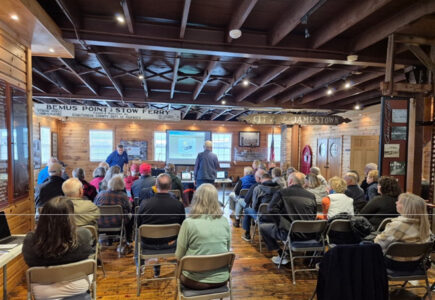County leaders respond to CLPOA criticisms

Photo submitted by CLPOA The Chautauqua Lake Property Owners Association's meeting 13, located at the Lawson Center in Bemus Point.
BEMUS POINT – The Chautauqua Lake Property Owners Association held another meeting on Saturday Nov. 1, which discussed ongoing efforts to push back on the New York state wetlands regulations and to create a centralized lake authority.
The meeting continued to note the lack of support from the Chautauqua County Executive and the Chautauqua County Legislature. With residential support for the CLPOA growing, County Executive PJ Wendel and Legislative Chairman Pierre Chagnon, R-Bemus Point, have responded to these claims of ineffective organizational management and poor lake management efforts.
In the executive address, Wendell discussed his previous support for the creation of the Chautauqua Lake Protection and Rehabilitation Agency. The CLPRA was created in 2017 through a legislative resolution. The organization was eventually terminated completely on Jan. 23, when the legislature went to vote on a $10,000,000 taxation plan. This was due to a motion that was introduced by a legislator as the alleged result of many constituents complaining about the proposed taxation plan. Wendell said the failure to create this lake district ultimately came from Wehrfritz leading opposition against the formation.
Chagnon also shared this account of events, stating that the plan would ultimately fail due to a public opposition campaign led by Wehrfritz. Wehrfritz denies any responsibility in the eventual failure of the CLPRA, claiming it to be the fault of rushed planning, poor transparency, and a lack of confidence in where this money would be spent. Wehrfritz stated that he was incredibly excited about this organization, despite numerous problems he believed were present at formation. Wehrfritz also did not feel that there was an appropriate amount of public communication at the time, leading himself and the town of Ellery to hold three public information meetings and suggest potential fixes.
Wehrfritz stated that concerns came from the proposed tax plan not having any sort of details or breakdown on how the funds would be allocated. While the legislature was asked to delay the vote on the tax plan until after January to better inform residents on the spending plans, the legislature chose not to do so which resulted in the concerns from residents, according to Wehrfritz. Wehrfritz stated that, due to these growing concerns, the legislature instead gave up and terminated the group instead of working to address concerns and move forward.
“You got the cart before the horse. Trying to pass a taxation plan of $10 million per year without telling the public what the $10 million would be used for, that was the issue,” stated Wehrfritz. “That’s what they got public pressure on, and the agency itself voted to terminate itself. So it was a great idea. Unfortunately, it wasn’t managed appropriately.”
Wendel noted that the creation of a lake authority district is something that would require the approval of the state. In the meantime, Wendell stated that he, and other county leaders, have decided to focus efforts on strengthening the Chautauqua Lake & Watershed Management Alliance.
“We’ve strengthened the Chautauqua Lake & Watershed Management Alliance by ensuring that every town and village surrounding the lake has a seat at the table, along with representatives from key lake stakeholder organizations. This structure not only promotes shared governance and collaboration but also makes Alliance board members — many of whom are elected by the public — directly accountable to the taxpayers and residents they represent,” Wendel said.
Wehrfritz took issue with the claims that these changes will have a positive impact on the organization’s work, work which Wehrfritz believes to have already proven the lack of effectiveness of the group. Wehrfritz stated that the changes to the alliance consisted of creating a board that is made up of 18 people, with nine of them representing local municipalities, six representing the three lake maintenance organizations, and three representatives from the county level. Wehrfritz believes that these changes will not cause significant change as the municipalities still only make up half of the members on the board. Additionally, Wehrfritz stated that the inclusion of lake maintenance organizations introduces a conflict of interest due to alliance funding, which partially comes from taxpayer money, being granted to these groups.
Wehrfritz also noted that there is concern over the increased lack of transparency from the alliance, noting that the public knows very little about these changes, aside from the restructuring of the board. Wherfritz said the alliance has slowly lessened the amount of public transparency for many years now. This has led to the organization hosting 12 meetings each year that were open to the public in about 2018, to one public meeting per year in November 2024, said Wehrfritiz.
“Go ahead and try to improve the alliance, which has not been effective at all, in the meantime while you’re pursuing a state approved district,” said Wehrfritz. “That will take a step in the right direction, but it won’t go far enough. And then there’s a whole other series of problems with the alliance that we’ve laid out, and I don’t know what, if anything, they’re doing anything about those because it’s all been done in secret.”
While Chagnon stated that the creation of a district remains difficult due to continuous state rejection, Chagnon did offer suggestions for ways to strengthen lake protection efforts. While the state owns the bottom and waters of the lake, Chagnon noted that towns and villages can utilize riparian rights to take some form of action at the moment. Chagnon also stated that municipalities and individuals can support both long-term and short-term maintenance through contributions to the present organizations that perform management and maintenance.
Wehrfritz also mentioned that the county continues to focus attention towards the Jefferson Project, which Wehrfritz believes has proven to be ineffective. Wehrfritz stated that the basic-level research that results from this project does not yield actionable recommendations, instead just resulting in more funding requests and studies. Wehrfritz stated that over the five years, and $5 million spent by the project, there has only been one released report in 2023 and no public accessibility to the work that has been done. Due to the fact that the county has funded $1,250,000 and a boat for the project, Wehrfritz thinks that it is time that the county move on from this solution and focus efforts toward a better long-term idea.
“I haven’t been able to find any significant documentation about how the county, or the institution, could be managing the project, even though they were funding it,” said Wehrfritz. “The money went through three or four hands before it got to the project. Who’s setting the objectives? Who’s storing the results? Who’s running the show?”




